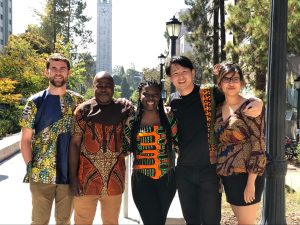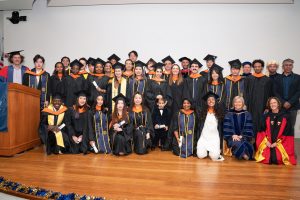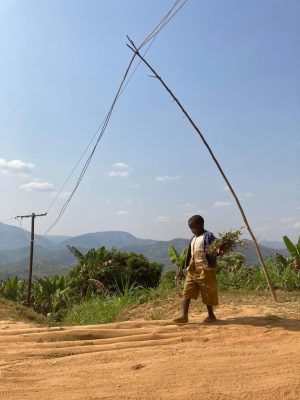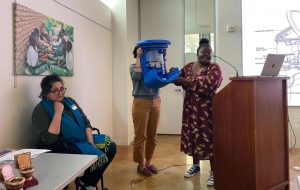By Abhik Pramanik
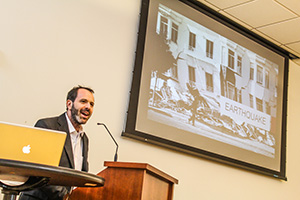 On October 20, the Blum Center for Developing Economies hosted a talk by Alex Thier, head of the Policy, Planning, and Learning Bureau at the U.S. Agency for International Development. Entitled “Ending Extreme Poverty: What UC Berkeley Can Do,” Thier’s talk centered around the Post-2015 Development Agenda, USAID’s role in the development community, and the need for bilateral and multilateral donors to partner with innovative entrepreneurs to make a difference.
On October 20, the Blum Center for Developing Economies hosted a talk by Alex Thier, head of the Policy, Planning, and Learning Bureau at the U.S. Agency for International Development. Entitled “Ending Extreme Poverty: What UC Berkeley Can Do,” Thier’s talk centered around the Post-2015 Development Agenda, USAID’s role in the development community, and the need for bilateral and multilateral donors to partner with innovative entrepreneurs to make a difference.
Thier reminded the packed hall that today roughly 1 billion people, or 18 percent of the world population, live in extreme poverty, which the World Bank defines as earning or consuming less than a $1.25 day. Although these numbers may seem alarmingly large, extreme poverty rates are actually down from more than 40 percent in 1990. This reduction represents a fulfillment of Millennium Development Goal 1: to halve the rate of extreme poverty by 2015.
With the imminent expiration of the Millennium Development Goals, the international community is now debating development goals for the next 15 years. Yet one objective is clear: almost every bilateral and multilateral organization, including the World Bank, USAID, the European Union, and the African Union, has set a target of bringing the number of people living in extreme poverty to zero by 2030.
Thier argued that the elimination of extreme poverty is a distinct possibility. While some scholars have talked about severe poverty as inevitable, the remarkable economic movement over the past two decades—which saw 700 million people lifted out of extreme poverty—proves otherwise. Moreover, the political will to tackle the problem seems to be growing. In his 2013 State of the Union Address, President Barack Obama declared that the U.S. would band together with its allies and partner to end extreme poverty by 2030. Additionally, both USAID and the World Bank have changed their mission statements within the past year to commit to ending extreme poverty.
Though naysayers still exist, Thier said he believes that the outcome ultimately rests on choices—at the individual, village, institutional, and country level to fight for economic development. He noted that the biggest obstacles to ending extreme poverty are fragile institutions and weak governance. Citing the examples of the Democratic Republic of Congo, Botswana, and the Republic of Korea, he summarized how each country took a divergent path since enduring various weaknesses in the 1960s.
Due to rapid industrialization, foreign capital investment, and intensive manufacturing, South Korea is now a high-income country, with a higher life expectancy than the U.S., and it has created its own agency for international development. The DRC, on the other hand, has experienced botched governmental policies leading to debt crises and a bloody civil conflict that has raged for decades. As a result, citizens of the DRC are currently among the world’s poorest. In another example, Botswana has experienced years of high growth followed by sharp economic downturns and even sharper rebounds because of its over-reliance on extractive industries. The lack of economic diversification has hindered Botswana’s development, but the country is still much better off than the DRC. Thier said he believes that the key distinction among these nations’ economic growth is their level of good governance and effective institutional capacity.
As a result of these insights, USAID recently adopted a “New Model of Development,” which centers on leveraging local ownership, engaging in public-private partnerships, scaling up innovative ideas, and using cutting-edge technology to deliver measurable results. To illustrate how this works, Thier talked about two USAID programs: Feed the Future and Power Africa. The former, started in 2009 in response to the global spike in food prices, works with local farmers to increase their crop quality and yields. The initiative currently runs in 19 countries and already has improved nutrition for 12 million children and pushed 7 million farmers out of extreme poverty. Power Africa was launched in 2013 to help the 400 million Africans who currently lack access to electricity. It aims to double the number of people with access to electricity in Sub-Saharan Africa through the use of innovative financial tools and by applying the lessons learned from the Feed the Future initiative. Within a year, Power Africa has leveraged $25 billion in capital with more than half coming from African nations and the private sector.
Thier ended his talk with a plea to the next generation of problem solvers. He said he hoped UC Berkeley students would heed his call to develop new ideas and technologies to help make development assistance more effective, so that by 2030 extreme poverty could be eliminated. Some of this work is being done by the Blum Center’s Development Impact Lab (DIL), which received a $20 million grant from USAID in 2012 to help transform the way universities source, design, evaluate, and scale up technologies that have a potential to alleviate extreme poverty. Currently, 90 DIL innovations are being tested and scaled in 30 countries, involving more than 500 interdisciplinary students, and over 400 industry, government, and social sector experts.

